You’re no blue blood any more, honey. The master bought you…and now he’s waitin’!
It is a film Clark Gable called the worst of his career.
Question: Was he right?
Answer: I haven’t seen all of Gable’s films, but I think he may have been on to something!
Where to begin one may ask. It probably begins and ends with one vision. Imagine if you will an aesthetically strong but overall an incredibly weak stab at recreating the magic that was – and is- Gone with the Wind.
The similarities are endless. The promotional art, Gable’s attire, and even the title screen are almost direct copies of their famous twenty year forebear. But what the earlier film captures in casting, detail, and overall production quality, Band of Angels exaggerates to garish proportions. The results are not good.
Clark Gable is Hamish Bond whose professional lineage varies as the film progresses. At the beginning he is a wealthy plantation owner and retired merchant captain. A bit later his former occupation was smuggling before his pedigree finally resolves itself and Bond is revealed as a former slaver.
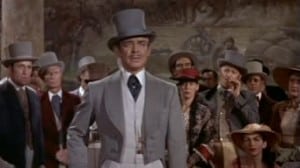 Though of course he doesn’t call it the slave trade, opting for a term that was improper in 1957 and downright offensive in today’s age. Throughout the film there is a sprinkling of similar language which truly diminishes the film. Even Gone with the Wind, which especially of late has increasingly come under fire for its portrayal of African Americans, steered well clear of such blatant abuses.
Though of course he doesn’t call it the slave trade, opting for a term that was improper in 1957 and downright offensive in today’s age. Throughout the film there is a sprinkling of similar language which truly diminishes the film. Even Gone with the Wind, which especially of late has increasingly come under fire for its portrayal of African Americans, steered well clear of such blatant abuses.
Gable’s co-star here is Yvonne De Carlo, most famous in her turn in television’s The Munsters. She’s adequate for what is expected of her, though of course far too young in comparison to the mature Gable. Again in both her attire and many of the camera angles (even the personality of her character) used she is clearly being positioned by director Raoul Walsh as a stand-in for one certain belle of Tara.
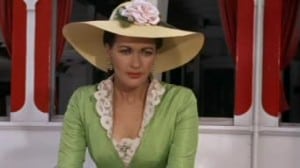 As Amantha Starr, Ms. De Carlo is the daughter of a wealthy Kentucky plantation owner. However on his untimely death, she learns that not only did he pass almost completely destitute, but that her mother is in fact one of the plantation’s slave. To further exacerbate the shock of her new situation, she learns that she too will be sold at a slave auction to help settle her father’s debts.
As Amantha Starr, Ms. De Carlo is the daughter of a wealthy Kentucky plantation owner. However on his untimely death, she learns that not only did he pass almost completely destitute, but that her mother is in fact one of the plantation’s slave. To further exacerbate the shock of her new situation, she learns that she too will be sold at a slave auction to help settle her father’s debts.
The third lead if you will, is Sydney Poitier as Rau-Ru, who has almost as convoluted a background as the other two. His background doesn’t become completely disclosed until the final act of the picture- (with Amantha’s disclosure taking the first third and Hamish’s taking the second). Turns out he was more or less adopted by Hamish during one of his “more successful” slave journeys.
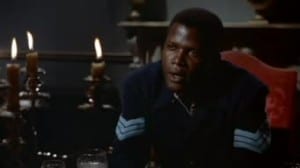 Since then he has taken young Rau-Ru as his own and treated him to the finest things his wealth can offer the young man, including secretly making him his heir.
Since then he has taken young Rau-Ru as his own and treated him to the finest things his wealth can offer the young man, including secretly making him his heir.
Now the convoluted family tree that is Band of Angels is complete.
The story takes place at the onset of the Civil War, with Bond and his new slave Amantha secure in his New Orleans residence. On hearing that Union soldiers are on their way, he heads up north to one of his plantations. While there and with the evil Yankees still closer, he burns his crops in direct contradiction to known orders from the invaders. His life now forfeit, he disappears to make his escape.
Along the way Amantha resists Bond’s generosity and struggles against Rau-Ru’s resentment. He is not only filled with hatred against the institution of slavery and all that it entails, but also (perhaps even more so) against Bond, who has taken care to try to better the lives of those he owns.
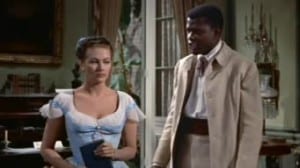 In the final act after all becomes clear, Rau-Ru finally reaches out and gets some sort of reconciliation presumably. And Amantha gets her man in the irascible Mr. Bond.
In the final act after all becomes clear, Rau-Ru finally reaches out and gets some sort of reconciliation presumably. And Amantha gets her man in the irascible Mr. Bond.
I think that the story here is supposed to be that beauty and the self-worth of a person bears no relation to the color of their skin, which is a truly noble and correct goal. And though the issues Gable and De Carlo bring up are noble (especially the very powerful and effective scene where Gable comes clean with his past and his attempts to make good on it), there is so much wrong here that the message gets garbled in the translation.
The language, as noted earlier, is offensive by most any standard. Much of the time when Gable’s slaves are on screen they sing and dance, a la The Song of the South. (When will that be on DVD?) Make a note of that.
But there are some strong points as well.
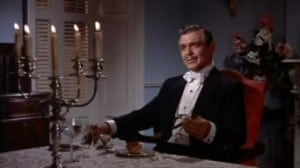 The cast is a strong one, with Sydney Poitier stealing the show, but Yvonne De Carlo giving perhaps one of her strongest performances and Gable being good in one of his last “macho” man roles.
The cast is a strong one, with Sydney Poitier stealing the show, but Yvonne De Carlo giving perhaps one of her strongest performances and Gable being good in one of his last “macho” man roles.
Clearly very little expense was spared in the film, with iconic exteriors of sprawling plantations. We also have riverboats and chases through swamps and the burning of one of Bond’s estates. There is plenty of eye candy in the scenery which is all wonderfully captured on screen.
There is quite a bit of historical accuracy in the picture, even though it is taken from a work of Robert Penn Warren’s. Slaveowners often did have children with their slaves and hid the truth from their offspring and families- think Thomas Jefferson. Historically as well the notion of any black blood labelling one as black holds water. Unfortunately our forebears thought in terms of black and white only without realize most of reality is some shade of gray.
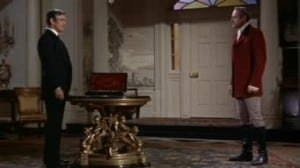 Lastly, some mention should be made of Raoul Walsh’s direction here as well. With 139 directing credits, Band of Angels marks almost the end of the storied director’s career, he only directed six more features. Take special note of the scenes I will reference only as “The Storm” and “The Duel.” In both the camera movements and shots are exemplary in driving emotion and tension.
Lastly, some mention should be made of Raoul Walsh’s direction here as well. With 139 directing credits, Band of Angels marks almost the end of the storied director’s career, he only directed six more features. Take special note of the scenes I will reference only as “The Storm” and “The Duel.” In both the camera movements and shots are exemplary in driving emotion and tension.
Ironically even Max Steiner’s score seems trite and rehashed here, though that was one of Steiner’s trademarks. Here again we have De Carlo (a white woman) playing a (partially) black woman. Suffice to say she looks as white as the driven snow. Though not right, it is no worse than the other casting decisions of the era, where whites routinely played most everything.
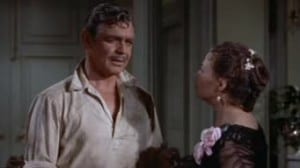 Sadly, the good points are just really good lipstick. And Band of Angels is a pig. The tremendous misjudgements on race bludgeon it.
Sadly, the good points are just really good lipstick. And Band of Angels is a pig. The tremendous misjudgements on race bludgeon it.
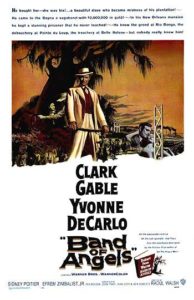
I really don’t know what to say about “BAND OF ANGELS”. I don’t bother comparing it to “GONE WITH THE WIND”, because the story is nothing like it. The story almost reminds me of “ALEX HALEY’S QUEEN”, except the protagonist is well aware that she was born a slave.
But what annoyed me about “BAND OF ANGELS” was that I found it so pretentious and patronizing, even when it was trying to comment on the horrors of slavery and racism.
Saw this movie 10 years ago. Wasn’t sure what I thought of it. Will look at it again.
Band of Angels has always ben my favorite film. I liked it much better than Gone With the Wind. I never tire of watching it when I get the opportunity.
Every SINGLE review of this movie mentions that Yvonne DeCarlo was miscast as a black woman. That’s NONSENSE! I’m part black, and I have relatives that look like that! Eyes, hair and everything!!
Band of Angels may not be a great film- but it’s pretty good, and very interesting. Yvonne DeCarlo could definitely pass for a biracial woman- with or without make- up. She reminds me a lot of Catherine Zeta- Jones. Sidney Poitier’s character is the highlight of the film. He is proud, intelligent, savvy- and refuses to play the role of a subservient negro. He not only beats up a white man- but is also shown slapping Ms. DeCarlo’s character- which was a very big deal in 1957. The music is grand- as is the casting. The beautiful Carolle Drake appears as Michelle- a mentor to Ms. DeCarlo’s character and a former paramour of the Gable character. In her day- Ms. Drake was celebrated as one of black America’s great beauties and was the wife of singer Billy Eckstine. She is every bit as enchanting as her leading lady. The veteran character actress- Tommie Moore does a nice turn as the feisty and rebellious house servant Dollie. Madame Sul-te-wan and the great Juanita Moore can be seen in small, uncredited roles. Clark Gable basically plays a 1957 version of Rhett Butler- albeit with a black son (Poitier). The film is too often compared to Gone with the Wind, for obvious reasons. While it is not nearly as ambitious as its’ predecessor- it is still an unusual offering for a film about the antebellum South- made in 1957. For fans of Gable, Poitier and Yvonne DeCarlo- it is well worth watching.
Anyone who tries to judge a film that is sixty years old by today’s standards is simply a plonker. It is a mediocre film, with some outstanding talent. And the remarks about Yvonne de Carlo being a “white” woman are incredibly ignorant. Her biological father was Polynesian, and her mother was Sicilian, so that probably tells you she had her share of non white heritage.
Searching for the Negro spiritual sang on the riverbank (steamboat) scene. Can anyone shed some light on the name of this song?